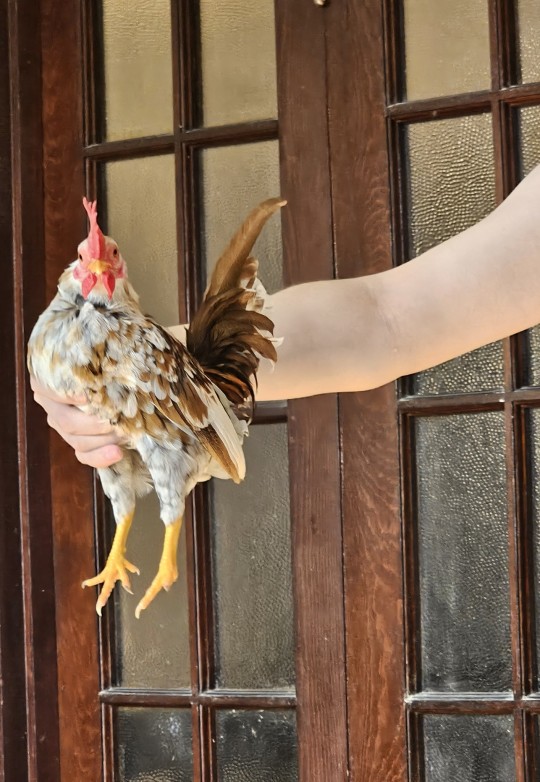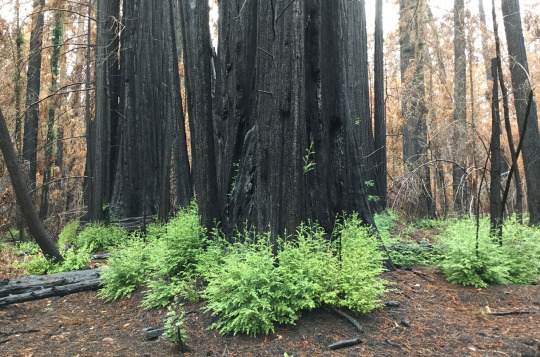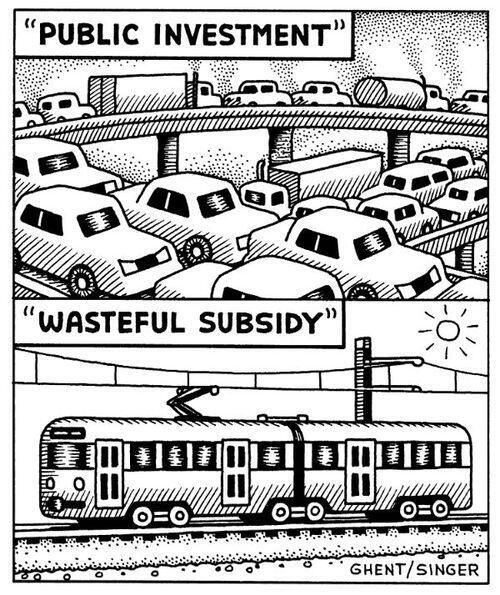Text
i think the thing that makes me the most emotional in life is the realization that everything i have and everything i see has been touched by other people. someone designed the logo of my favorite tea bags and someone decided which paintings should go in the calendar hanging on my wall. someone built the roof above my head and someone paved the street outside my house. someone made this pair of glasses specific for me, someone picked the pear i ate with my lunch and someone designed my favorite sweater. every book i read, every song i listen to, every film i watch, tens, if not hundreds of people had to be there to make it happen. even if i am alone, i am always surrounded by other human beings - a fact that makes my heart squeeze in on itself everytime i remember it.
39K notes
·
View notes
Text


I love how his little legs dangle lol he triggers my cute aggression so bad though
1K notes
·
View notes
Text
I have just learned that Mountain Goats are NOT, in fact, actual Goats.
159K notes
·
View notes
Text
I love you tailors, I love you recycling center employees, I love you jewelry repair people, I love you tech repair people. I love you plumbers, I love you electricians. I love you all maintenance workers, who make it so things don't have to be fully replaced when they break.
There are so many ways to contribute to the climate movement.
6K notes
·
View notes
Text
"A century of gradual reforestation across the American East and Southeast has kept the region cooler than it otherwise would have become, a new study shows.
The pioneering study of progress shows how the last 25 years of accelerated reforestation around the world might significantly pay off in the second half of the 21st century.
Using a variety of calculative methods and estimations based on satellite and temperature data from weather stations, the authors determined that forests in the eastern United States cool the land surface by 1.8 – 3.6°F annually compared to nearby grasslands and croplands, with the strongest effect seen in summer, when cooling amounts to 3.6 – 9°F.
The younger the forest, the more this cooling effect was detected, with forest trees between 20 and 40 years old offering the coolest temperatures underneath.
“The reforestation has been remarkable and we have shown this has translated into the surrounding air temperature,” Mallory Barnes, an environmental scientist at Indiana University who led the research, told The Guardian.
“Moving forward, we need to think about tree planting not just as a way to absorb carbon dioxide but also the cooling effects in adapting for climate change, to help cities be resilient against these very hot temperatures.”
The cooling of the land surface affected the air near ground level as well, with a stepwise reduction in heat linked to reductions in near-surface air temps.
“Analyses of historical land cover and air temperature trends showed that the cooling benefits of reforestation extend across the landscape,” the authors write. “Locations surrounded by reforestation were up to 1.8°F cooler than neighboring locations that did not undergo land cover change, and areas dominated by regrowing forests were associated with cooling temperature trends in much of the Eastern United States.”
By the 1930s, forest cover loss in the eastern states like the Carolinas and Mississippi had stopped, as the descendants of European settlers moved in greater and greater numbers into cities and marginal agricultural land was abandoned.
The Civilian Conservation Corps undertook large replanting efforts of forests that had been cleared, and this is believed to be what is causing the lower average temperatures observed in the study data.
However, the authors note that other causes, like more sophisticated crop irrigation and increases in airborne pollutants that block incoming sunlight, may have also contributed to the lowering of temperatures over time. They also note that tree planting might not always produce this effect, such as in the boreal zone where increases in trees are linked with increases in humidity that way raise average temperatures."
-via Good News Network, February 20, 2024
13K notes
·
View notes
Text

Solar energy has so many benefits. Raising salaries for teachers is such a needed narrative.
36K notes
·
View notes
Text
There is hope. I promise. Young people just won their case against the state of Montana. Ecuadoreans braved escalating political violence to vote against oil drilling in the Amazon. Brazilian deforestation is down by enormous amounts since Lula took office. They’ve invented hydropanels that synthesise pure water from the air. People are farming in solar parks. A ship just launched for its maiden voyage using rigid sails designed to mimic wind turbine blades. EV sales are taking off, and, more crucially, cities are re-assessing their very relationship with the car. By the 2024 Olympics the river Seine will be safe for people to swim in again. More and more people are replacing their gas boilers with heat pumps. Solarpunks are growing crops in their back garden and distributing them to their neighbours. Great tracts of land are being given back to nature. Young people are channelling their energies into meaningful careers. Pilots are leaving the aviation industry. Yes, the world is dark and terrible and full of awful dangers that keep you up at night, but we are a huge movement that grows every day in numbers and power. Your small actions matter. Our collective triumphs are increasing. Things are going to get harder, extreme weather will be more common, but with ingenuity, resilience and crucially, COMMUNITY, we can build an equitable world on this strange, tired old planet. See you in the future.
17K notes
·
View notes
Text
Ancient redwoods recover from fire by sprouting 1000-year-old buds

Article | Paywall free
When lightning ignited fires around California’s Big Basin Redwoods State Park north of Santa Cruz in August 2020, the blaze spread quickly. Redwoods naturally resist burning, but this time flames shot through the canopies of 100-meter-tall trees, incinerating the needles. “It was shocking,” says Drew Peltier, a tree ecophysiologist at Northern Arizona University. “It really seemed like most of the trees were going to die.”
Yet many of them lived. In a paper published yesterday in Nature Plants, Peltier and his colleagues help explain why: The charred survivors, despite being defoliated [aka losing all their needles], mobilized long-held energy reserves—sugars that had been made from sunlight decades earlier—and poured them into buds that had been lying dormant under the bark for centuries.
“This is one of those papers that challenges our previous knowledge on tree growth,” says Adrian Rocha, an ecosystem ecologist at the University of Notre Dame. “It is amazing to learn that carbon taken up decades ago can be used to sustain its growth into the future.” The findings suggest redwoods have the tools to cope with catastrophic fires driven by climate change, Rocha says. Still, it’s unclear whether the trees could withstand the regular infernos that might occur under a warmer climate regime.
Mild fires strike coastal redwood forests about every decade. The giant trees resist burning thanks to the bark, up to about 30 centimeters thick at the base, which contains tannic acids that retard flames. Their branches and needles are normally beyond the reach of flames that consume vegetation on the ground. But the fire in 2020 was so intense that even the uppermost branches of many trees burned and their ability to photosynthesize went up in smoke along with their pine needles.
Trees photosynthesize to create sugars and other carbohydrates, which provide the energy they need to grow and repair tissue. Trees do store some of this energy, which they can call on during a drought or after a fire. Still, scientists weren’t sure these reserves would prove enough for the burned trees of Big Basin.
Visiting the forest a few months after the fire, Peltier and his colleagues found fresh growth emerging from blackened trunks. They knew that shorter lived trees can store sugars for several years. Because redwoods can live for more than 2000 years, the researchers wondered whether the trees were drawing on much older energy reserves to grow the sprouts.
Average age is only part of the story. The mix of carbohydrates also contained some carbon that was much older. The way trees store their sugar is like refueling a car, Peltier says. Most of the gasoline was added recently, but the tank never runs completely dry and so a few molecules from the very first fill-up remain. Based on the age and mass of the trees and their normal rate of photosynthesis, Peltier calculated that the redwoods were calling on carbohydrates photosynthesized nearly 6 decades ago—several hundred kilograms’ worth—to help the sprouts grow. “They allow these trees to be really fire-resilient because they have this big pool of old reserves to draw on,” Peltier says.
It's not just the energy reserves that are old. The sprouts were emerging from buds that began forming centuries ago. Redwoods and other tree species create budlike tissue that remains under the bark. Scientists can trace the paths of these buds, like a worm burrowing outward. In samples taken from a large redwood that had fallen after the fire, Peltier and colleagues found that many of the buds, some of which had sprouted, extended back as much as 1000 years. “That was really surprising for me,” Peltier says. “As far as I know, these are the oldest ones that have been documented.”
... “The fact that the reserves used are so old indicates that they took a long time to build up,” says Susan Trumbore, a radiocarbon expert at the Max Planck Institute for Biogeochemistry. “Redwoods are majestic organisms. One cannot help rooting for those resprouts to keep them alive in decades to come.”
-via Science, December 1, 2023
11K notes
·
View notes
Text
walkable cities also means sittable cities send tweet
148K notes
·
View notes
Text
Saw a post about helping people that used the analogy of "if you see someone fall off a cruiseship and theres a life preserver ring on the wall next to you do you walk away or do you throw them the life preserver? Of course you throw them the life preserver." And i dont want to add to or tag the post with any sort of correction because its literally not the point at all but i am desperate to say that the first thing they teach you when you work on a cruise ship is that if someone falls overboard you Do Not Look Away
If theres a life preserver nearby but you have to turn your back to get it, tough luck. If theres someone nearby who can't hear you but you could run and get them, absolutely not. You see someone go overboard you point at them and never ever let them out of your sight because looking away even once could mean losing them forever, so you just have to trust that someone will hear you scream for help but you cant for any reason look away
And maybe that adds to the life preserver metaphor somehow but mostly i just need you to know if you spot someone in the water you point at them and you watch them close and you scream for help
35K notes
·
View notes






